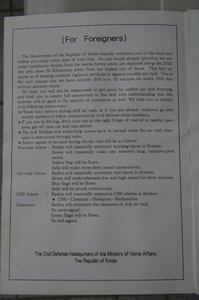|
|
|
|
|
|
 |
Notice in hotel room - incase of invasion
from the North!
click to read larger image |
|
|
|
|
|
|
|
Mt Seoraksan National Park area
The drive from Seoul to Mt Seoraksan was
about 3.5 hours. We stopped for a break at
an expressway services station in which there
was a huge shop of 'dick-stick’
art. Large wooden carvings of the male penis
were also prominent in the shops in Seorak.
Seorak was named because the snow would not
melt for a long periods and the rocks stayed
white like snow. It was designated as a biosphere
preservation district by UNESCO. You can
see fantastic rock formations and superb
forests.
Cable Car to Gwonkeumsansung Fortress
Due to the low cloud we could only imagine
the views of the fascinating rock formations
of the Gwongeumseong region and Sogongwon
area. We didn’t risk the 20 minute
hike to Gwongeumseong to get a birds-eye-view
of Oe-Serok.
|
|
|
|
|
|
|
|
|
|
|
|
|
|
|
|
|
|
|
|
|
|
|
|
|
|
|
|
|
|
|
|
|
|
|
|
|
|
|
|
|
|
|
|
|
|
|
|
|
|
|
|
|
|
|
|
|
|
|
|
|
|
|
|
|
|
|
|
|
|
|
|
|
|
|
|
|
|
Shinheungsa Temple
At the base of the cable car you can enter
the Sinheungsa, temple which used to be called
Hyangseongsa. It was built by Jajangyulsa
(590~658), who travelled to famous mountains
all over the nation, in Queen Jindeok’s
(?~654) 6th year of reign. It was destroyed
and has been rebuilt many times since.
On the path to Sinheungsa, there is a great
10 metre high bronze statue called Bronze
Jwabul Statue. Just beyond the statue, which
is on a granite terrace, there is a bridge
to the right called Hyeonsugyo, which was
newly built for crossing the ravine. Past
the bridge there is a long stone wall with
a Cheongwang door, and you can enter the
temple. At the entrance there are four Cheonwang
(king) statues (Jiguk Cheonwang with a sword,
Damun Cheonwang with a lute, Gwangmok Cheonwang
with a tower, and Jeungjang Cheonwang with
a dragon), placed on either side. The Buddhist
statues at Sinheungsa were placed here during
the founding days of Seongjeongsa, and include
the statues Mireukbosal, Gwaneumbosal and
Seji which were sculpted by Uisang Daesa.
The buildings which were built during that
time are still standing, like the sanctuary,
main temple, Myeongbujeon, Bojaeru, and Chilseonggak,
etc. There is also an important cultural
three-story stone tower, called Hyangseongsaji.
|
|
|
|
|
|
|
|
|
|
|
|
|
|
|
|
|
|
|
|
|
|
|
|
|
|
|
|
|
|
|
|
|
|
|
|
|
|
|
|
|
|
|
|
|
|
|
|
|
|
|
|
|
|
|
|
|
|
|
|
|
|
|
|
|
|
|
|
|
|
|
|
|
|
|
|
|
|
Daepohang Fishing Port (Fish Market)
The port is filled with raw fish restaurants
and a live fish market containing eel, flounder,
yellowtail, squid, shrimps, crab and a plethora
or high-end seafood. Local delights include
ojingeo sundae and gamja songpyeon. For lunch,
simply – choose your fish and it is
chopped to eat raw or grilled or steamed.
It was rather disturbing to see the large
fish beaten to death with a baseball bat
and the gutting of a live octopus.
|
|
|
|
|
|
|
|
|
|
|
|
|
|
|
|
|
|
|
|
|
|
|
|
|
|
|
|
|
|
|
|
|
|
|
|
|
|
|
|
|
|
|
|
|
|
|
|
|
|
|
|
|
|
|
|
|
|
|
|
|
|
|
|
|
|
|
|
|
|
|
|
|
|
|
|
|
|
|
|
|
|
|
|
|
|
|
|
|
|
|
|
|
|
|
|
|
|
|
|
|
|
|
|
|
|
|
|
|
|
|
|
|
|
|
|
|
|
|
|
|
|
|
|
|
|
|
|
|
|
|
|
|
|
|
|
|
|
|
|
|
|
|
|
|
|
|
|
|
|
|
|
|
|
|
|
|
|
|
|
|
|
|
|
|
|
|
|
|
|
|
|
|
|
|
|
|
|
|
|
|
|
|
|
Naksan Temple (and Naksan Beach)
Naksansa or Naksan Temple is a Korean Buddhist
temple complex in the Jogye order of Korean
Buddhism that stands on the slopes of NaksanMountain
(also called "Obongsan Mountain").
Founded in 671, it is one of the few temples
in Korea to overlook the Sea of Japan (East
Sea).
Naksan temple grounds were ravaged by a
wildfire in 2005, but the damaged or destroyed
buildings were almost completely restored
by July 2006 at a cost of $3m. The 16-meter/53
feet-tall statue known as Gwanseum-Bosal
is a depiction of the Haesugwaneumsang (Bodhisattva
of Mercy) and is the most prominent feature
at the site.
|
|
|
|
|
|
|
|
|
|
|
|
|
|
|
|
|
|
|
|
|
|
|
|
|
|